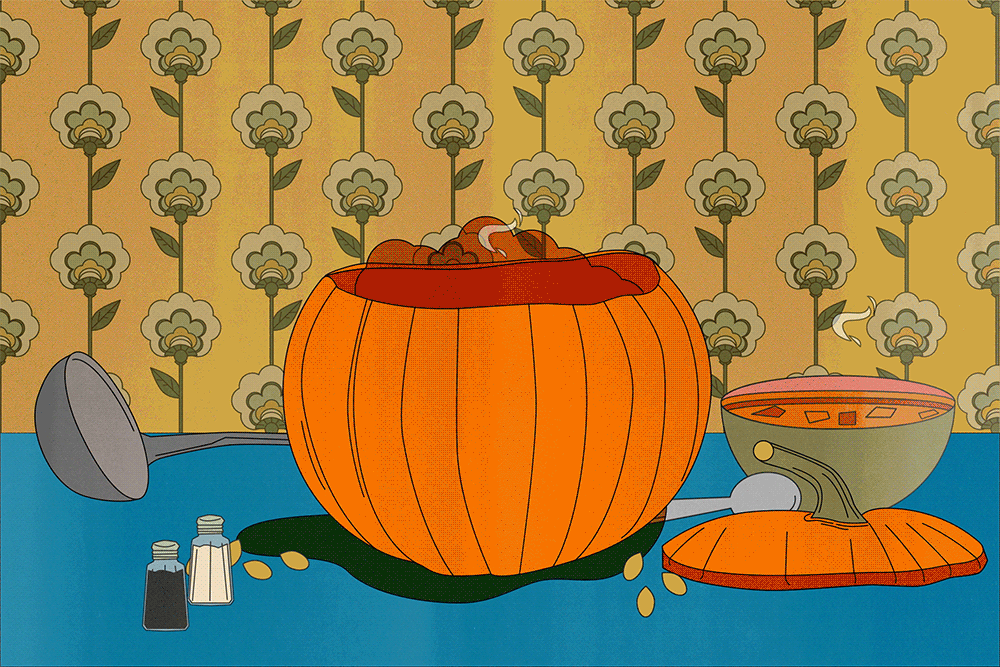
This genius method turns a pumpkin into the cooking vessel, the serving bowl, and the soup itself.
“It’s not weird. It’s really delicious, and it’s a beautiful, sassy dish,” Ruth Reichl tells Terry Gross in a 2009 interview for NPR’s Fresh Air. She’s defending the honor of her “Swiss pumpkin,” a bread-and-cheese-layered, hollowed-out pumpkin that is filled with cream and stock, baked, and served straight from the squash. Reichl developed the recipe in the 1970s, when she was 21 and writing her first cookbook, Mmmmm: A Feastiary.
“My husband and I had just moved to New York, where we shared a loft on the Lower East Side with performance artist Pat Oleszko. Living with two artists made me think about cooking in a whole new way…. I started thinking of food in a very visual way,” Reichl tells me. “When pumpkins appeared in the market, I thought about how beautiful they are, and it just hit me that they would make perfect soup terrines.”
Reichl, of course, wasn’t the first to treat a pumpkin as a soup vessel. The chef André Soltner wrote about his mother’s potage au potiron in the New York Times in 2013, served to Soltner and his siblings as kids in Alsace 75 years prior. When the piece was published, Soltner was 81, yet the soup was anything but old hat. In the story’s accompanying video, he makes the dish—which cooks on the stove in a pot, not in the oven or inside a pumpkin, like Reichl’s. Still, the soup is served inside the squash, after being thickened with croutons and pumpkin flesh scraped from the inside of the raw serving vessel (in the video, Soltner also chooses on the fly to thin the soup with an entire bottle of white wine).
The soup is almost entirely hands-off after the pumpkin is hollowed and the raw ingredients dumped in.
In a pumpkin-pie-themed episode of his cult-classic show Good Eats, Alton Brown makes a version of this dish that he calls “pumpkin pie” soup. “The only oven housed in the early American home was the hearth,” mused Brown. “A traditional pie with a crust, pan, and filling would’ve been pretty much impossible.” He explains that early iterations of the pumpkin pie were not far off in spirit from this soup—a pumpkin with a rich filling, placed by the hearth until the squash was tender and sweet.
As Reichl points out, using a pumpkin as a serving dish is definitely a visual choice, but it’s also a pragmatic choice. Though they check the popular “one-pot meal” box, soups typically require a bit of babysitting: You sauté aromatics, pour in this and that at different times, and stir regularly. Baking it all in the pumpkin is closer to using an Instant Pot. The soup is almost entirely hands-off after the pumpkin is hollowed and the raw ingredients dumped in. Better still, when the soup is finished, there’s no stockpot to wash. Eat the baked pumpkin exterior with an additional sprinkle of salt (skin, too!) and compost the stem.
When you’re picking out the pumpkin, figure you’ll need about a pound of pumpkin per serving of soup, and head to the farmers market or grocery store—not the pumpkin patch. While edible, most large pumpkins destined to be plunked on stoops for Halloween are tasteless and stringy; look for sweet-fleshed baking pumpkins like sugar pie, Cinderella, or cheese. Each variety will bake for a slightly different amount of time based on thickness of skin and flesh, but like any roasted produce, they’re easy to pierce with a cake tester to check for doneness.
After carving open a lid, scoop out the pumpkin pulp and seeds, the latter of which you’ll season, bake, and serve on top of your soup. Compost the rest of the innards. Fill the rest of the cavity with raw shallot, garlic, stock, and coconut milk or heavy cream. Maple syrup enhances the pumpkin’s natural sweetness, while cumin and cardamom bring a bit of warm earthiness and herbal, citrusy notes into the mix. Bake the pumpkin, then scoop some of the soft flesh from the pumpkin walls into the liquid. If you want a smoother texture, an immersion blender is easily popped into the pumpkin’s opening.
If overbaked, nothing will be affected flavor-wise, but the pumpkin’s bottom may spring a leak. If this happens, don’t freak out. Just transfer the liquid into a stockpot or a Dutch oven. Tear the remaining pumpkin flesh and add it to the pot. Puree the whole mixture, along with another good splash of stock and cream, and a big pinch of salt.
Ultimately, even if the baked pumpkin looks a bit wonky, it’s worth serving. As Reichl explains, when she made Swiss pumpkin for her roommates in the ’70s, they loved when the exterior would begin to slump: “When I served it, all any of us could think about was that, in its slightly deflated state, it looked exactly like a Claes Oldenburg sculpture.”